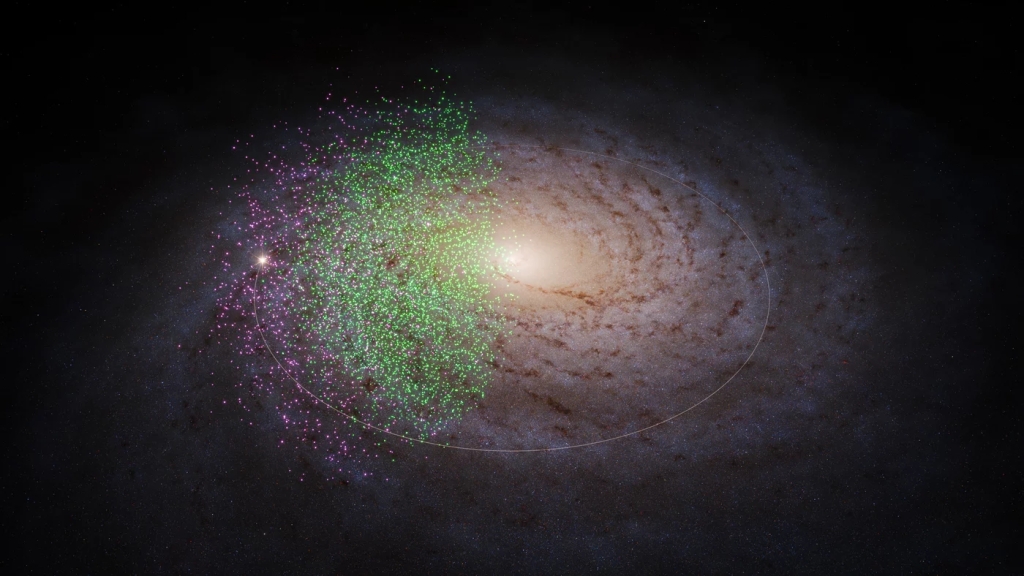In Today’s Science News, we learn about the discovery of the possibly earliest building blocks of our home galaxy and that while global groundwater depletion has been accelerating it is anything but inevitable. At the end of the second article a short commentary of mine regarding water scarcity and climate change.

(source: Pixabay)
Article 1: Two of the Milky Way’s earliest building blocks identified
SD-Date: March 21, 2024
Et-Date: March 25, 2024
ScienceDaily-Summary: „Astronomers have identified what could be two of the Milky Way’s earliest building blocks: Named ‚Shakti‘ and ‚Shiva‘, these appear to be the remnants of two galaxies that merged between 12 and 13 billion years ago with an early version of the Milky Way, contributing to our home galaxy’s initial growth. The new find is the astronomical equivalent of archeologists identifying traces of an initial settlement that grew into a large present-day city.“
Open-Access: https://iopscience.iop.org/article/10.3847/1538-4357/ad1885
Method of Research
The research was conducted by Khyati Malhan and Hans-Walter Rix of the Max Planck Institute for Astronomy. It required combining the data for 6 million stars from ESA’s Gaia mission which has, since it was launched in 2013, gathered data of the position and distance of 1.5 billion stars within our galaxy. The Sloan Digital Sky Survey (DR17) provided the information about the stars‘ chemical composition.

| Gaia’s Mission |
| „Throughout the course of its mission, Gaia monitors each of its target stars about 14 times per year. It is precisely charting their positions, distances, movements, and changes in brightness. It is expected to discover hundreds of thousands of new celestial objects, such as extra-solar planets and brown dwarfs, and observe hundreds of thousands of asteroids within our own Solar System. The mission is also studying more than 1 million distant quasars and providing stringent new tests of Albert Einstein’s General Theory of Relativity.“ |
| (source: https://www.esa.int/Science_Exploration/Space_Science/Gaia_overview) |
Findings
At first it seems impossible to identify stars that mingled with our galaxy (or rather an earlier version of it) 12 to 13 billion years ago, since the current Milky Way is 100,000 light years across (one light year is the distance light travels in one year) the furthest back we could see is 100,000 years. And that only accounts for those stars that are that far away.
Luckily, basic physics comes to the aid: „When galaxies collide and their stellar populations mingle, most of the stars retain very basic properties, which are directly linked to the speed and direction of the galaxy in which they originated. Stars from the same pre-merger galaxy share similar values for both their energy and what physicists call angular momentum — the momentum associated with orbital motion or rotation.“ (Science Daily)
The energy and the angular momentum are conserved, now you have to look for large groups of stars with these unusual values. Moreover, older stars have a lower metal content (called metallicity) than stars that formed more recently so you know what you have to look for as well.
By combining the Gaia data with the detailed stellar spectra from the Sloan Digital Sky Survey, they observed that two groups of like-minded stars had comparatively large angular momentum which was consistent with groups of stars that had been part of different galaxies. Malhan named these two structures after Shiva, who is one of the principal deities of Hinduism, and Shakti, who is a female cosmic force that is often portrayed as Shiva’s consort. Both had an overall low metallicity and their energy and angular momentum also point to them being good candidates for the earliest ancestors of our galaxy. Below you see a visualization of the two groups.

It is worth to keep an eye on this topic as there are ongoing or bound to start surveys which, thanks to additional information regarding spectra (SDSS-V, 4MOST) and precise distances (LSST/Rubin Observatory), will show whether Shaktiv and Shiva are indeed a glimpse into our galaxy’s prehistoric past.
Sources
Two of the Milky Way’s earliest building blocks identified
https://www.sciencedaily.com/releases/2024/03/240321155515.htm
Shiva and Shakti: Presumed Proto-Galactic Fragments in the Inner Milky Way
https://iopscience.iop.org/article/10.3847/1538-4357/ad1885
Gaia Overview
https://www.esa.int/Science_Exploration/Space_Science/Gaia_overview
Our Milky Way Galaxy: How Big is Space?
https://exoplanets.nasa.gov/blog/1563/our-milky-way-galaxy-how-big-is-space/
Article 2: Global groundwater depletion is accelerating, but is not inevitable
SD-Date: January 24, 2024
Et-Date: March 26, 2024
ScienceDaily-Summary: „Groundwater is rapidly declining across the globe, often at accelerating rates. Researchers now present the largest assessment of groundwater levels around the world, spanning nearly 1,700 aquifers. In addition to raising the alarm over declining water resources, the work offers instructive examples of where things are going well, and how groundwater depletion can be solved. The study is a boon for scientists, policy makers and resource managers working to understand global groundwater dynamics.“
Open-Access: https://www.nature.com/articles/s41586-023-06879-8
Method of Research
The research was conducted by the UC Santa Barbara researchers who assessed the groundwater levels of 1,700 aquifiers over the past 100 years. Overall, it took three years for the study of which two years alone were spent on making sense of 300 million water level measurements from 1.5 million wells.
The next step was to translate the flood of data into actual insights about global groundwater trends. For that, the team analyzed over 1,200 publications „to reconstruct aquifer boundaries in the regions of inquiry and evaluate groundwater level trends in 1,693 aquifers“.
Finally, they were complemented by the data from the Gravity Recovery and Climate Experiment (GRACE) – twin satellites that precisely measure the distance between them and the wells they monitor to detect small fluctuations in our planet’s gravity.
It is useful for both understanding the dynamics of aquifers at large scales and helps in places where there’s no locally available data.
„This local resolution is critical, as the authors found out, because adjacent aquifers can display different trends.“

| GRACE Overview |
| „The GRACE twin satellites, launched 17 March 2002, are making detailed measurements of Earth’s gravity field changes and revolutionizing investigations about Earth’s water reservoirs over land, ice and oceans, as well as earthquakes and crustal deformations. The two GRACE satellites have completed more than 13 years of continuous measurements!“ |
| (source: https://grace.jpl.nasa.gov/mission/grace/) |
Findings
- In 71% of the aquifers, the groundwater has been dropping.
- The rates of decline in the 1980s and ’90s sped up from 2000 to present.
- In arid and semi-arid lands under cultivation, groundwater deepening is more common and even shows accelerated decline (in three times as many places as it was expected by chance).
- In 16% of the aquifers, the groundwater decline since the 80s and 90s has been reversed (half as common as it was expected by chance).
- Where groundwater remains stable, it can still affect nearby streams and surface water to leak into the subsurface if withdrawn.
- The precipitation variability was also analyzed for 542 aquifers over the past 40 years.
They found that 90% of aquifers where the decline were accelerating are in places where conditions have gotten drier. Climate variability, on the other hand, can also cause groundwater to rebound where conditions become wetter.
Measures
In the article, two measure were mentioned to combat this trend – one needs direct intervention into nature and the other is of regulatory nature of demand or supply.
- Allocation of water: Take Tucson, Arizona
In order to replenish the aquifer in the nearby Avra Valley, water from the Colorado River was allotted to store water for future use. One thing that made it easier for the Avra Valley was their geology which makes it easier to store vast quantities of water underground. It is less disruptive and dangerous than building infrastructure above ground and it can store sixfold more water per dollar than surface reservoirs.
However, the drawback of reallocating the water to the underground reservoir results in the river only rarely reaching its delta in the California Gulf.

- Reducing Demand
Another way to combat it is the reduction of demand through regulations, permitting and fees for groundwater use. „To this end, [Perrone] is currently examining water law in the western U.S. to understand these diverse interventions. Regardless of whether it comes from supply or demand, aquifer recovery seemed to require intervention, the study revealed.“
Commentary: Water Scarcity
Since we are already discussing groundwater in this scientific article, I’d like to add that we have to avoid resource wars – especially water wars – in the near and distant future. This can only be achieved through cooperation and compassion, it goes without saying that the population has priority over the industry meaning the latter needs to work more intensively on solutions how to reduce their water consumption.
Combatting climate change is as important as ever, because as we have seen: where it has gotten drier, the groundwater dwindles. So, regions where it is already a problem will only get worse if there’s not an energetic and continuous effort to reduce our carbon emissions and reverse it through measures like reforestation or carbon capture and storage – if technologically possible, but we shouldn’t put too much hope in a Wundertechnologie (miracle technology) and lose sight of what can already be done.
Even if we did reduce our carbon emissions to 0 in an instant, there’s still the aftermath we have to deal with. Mitigation is therefore key and that means to let the poor countries and the minorities, the vulnerable groups and younger people in our own country have a say too. In Greece for instance, if I recall correctly, there were cool rooms in the hot Summer months made available for everyone as a safe haven. For younger generation, measures would include further expansion of renewable energies to end the dependency on fossil fuels for once and for all – if necessary, nuclear energy too as complementary energy.
Sources
Global groundwater depletion is accelerating, but is not inevitable
https://www.sciencedaily.com/releases/2024/01/240124132724.htm
GRACE and GRACE-FO (Image source)
https://en.wikipedia.org/wiki/GRACE_and_GRACE-FO
GRACE Mission Overview
https://grace.jpl.nasa.gov/mission/grace/
The Colorado River Delta Is Proof of Nature’s Resiliency
https://www.nrdc.org/stories/colorado-river-delta-proof-natures-resiliency
Thank you for reading! Next time, I’ll write about three scientific articles again. Also, I finally rediscovered why I love writing about science, even if my summaries are rather mediocre and I still struggle a bit to not rephrase sentences. See you next time!
